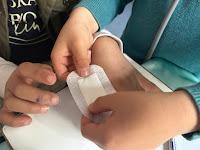Socio-dramatic Play
I have been lucky enough to be part of Jo Fahey's online workshop 'The Power of Play' for the past four weeks. We explored many different types of play through various lenses, but I have chosen to focus this blog post on socio-dramatic play. Other types of play that might be synonymous or connected with socio-dramatic play include role play, pretend play, imaginative play, make-believe play, symbolic play, dramatic play and fantasy play. It is important to note that each intentionally use the word 'play' to allow children choice and to self-direct their learning, in contrast to 'drama lessons'.
Much has been written about socio-dramatic play being 'the most advanced' or 'the highest form' type of play. This is based on the idea that it combines functional play (playing with objects as they are), constructive play (playing to combine materials and making something new) and games with rules (playing with rules that are adopted, adapted or invented). Socio-dramatic play develops children's skills in communication (speaking, listening...), thinking (creativity, imagination...), socialising (empathy, negotiation...) and self-management (organisation, resilience). Despite its accolades, I don't necessarily think it's 'better' or 'more important' than other types of play such as physical play (racing, climbing, dancing...) and exploratory play (painting, tinkering, using all of our senses...). Different play types help children to learn different skills, understand different concepts and develop different dispositions.
Saying this, I realised the children in my Kindergarten class were not engaged in a lot of socio-dramatic play with each other and I began to think about why! The ultimate reason was that I hadn't taken the time to think about what socio-dramatic might look like, wasn't explicit in language that could intrigue children, and wasn't intentional enough in using varied resources that might invite children to engage in role play.
A 'solution' I avoided was to set up and dictate one setting in an area of the classroom (such as a hospital or a cafe) and to invite children to engage in socio-dramatic play by introducing a set of plastic fruit and vegetables in the classroom. As I experimented with different ideas, Jo also pushed my thinking and helped me to recognise some of the roles that were already being shown by the children. A group of children had been planning and putting on 'human structure' shows for the 3- and 4-year olds. They were being gymnasts and event organisers. Another group were using Lego to create Beyblades. They were being designers.
This blog offers some of the invitations I offered to Kindergarten students to engage in more socio-dramatic play. Beyond play, many of these resources and approaches could be used to develop playful opportunities to explore aspects of scope and sequence documents such as storytelling, historical reenactments and buying and selling with money, and approaches to drama such as Mantle of the Expert.
The introduction of fabrics has been key in exploring socio-dramatic play. Children were invited to use their imagination as they engaged with the fabrics. So many possibilities from open-ended materials which led to discussions on characters, events, objects and places that connected to storytelling.
 |
| Fire |
 |
| A ghost |
 |
| "We are driving a car." |
The fabrics were then available as loose parts in the classroom, but stored in a basket they were hidden away. We have hung the fabrics up to make them more visible, and since this, children have used them in their socio-dramatic play and with other loose parts to design structures and develop stories.
 |
| Googly eyes prompted some children to create stick puppets which children used to take on roles |
 |
| A whiteboard was used as a noticeboard in a doctor's surgery |
Misty Paterson's PopUp Studio uses the acronym CME to show us learning can begin with concepts, materials or experiences. These examples show the importance of materials, and how children make connections to lived or imaginary experiences with infinite concepts as possibilities to explore. The doctor's surgery in the last photo was initiated by a child who had just broken her leg showing events and first-hand experiences can be great sparks for play.
The children had already displayed a lot of imagination and creativity in the way they formed and told narratives from their use of loose parts and a joy in using different materials to design constructions ranging from palaces and islands to animal homes and witches' hideaways. To connect to and build on their interest in storytelling, the children created collages to represent settings and characters and thought about an event that would make the story interesting. They then used these ideas to bring the story to life through socio-dramatic play. This prompted some children to create props and to use loose parts and objects symbolically to represent other things. In one photo below, a group are using beaters for musical instruments as magic wands!
The use of small world play resources triggered a lot of interest from the children and prompted them to take on quite different roles.
Diverse characters provoked children to invent voices, personalities, roles and stories to enact.
 |
| Kindergarten love animals. These finger puppets encouraged children to take on different sounds and movements and consider their interactions as the children 'became' the animals. |
 |
| Knights and dragons triggered teams of 'good' and 'bad' and narratives based on conflicts and their outcomes. Children assumed different roles using their bodies and voices to take on new roles. |
 |
| Some children used Kapla to help sequence events in their drama |
 |
| Some children used Lego to build settings to frame storylines they were developing |



















Comments
Post a Comment